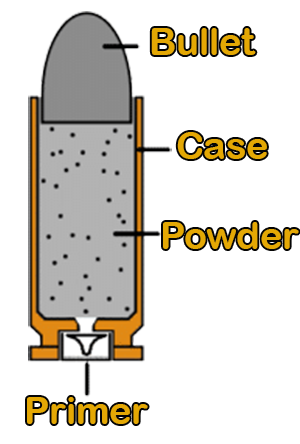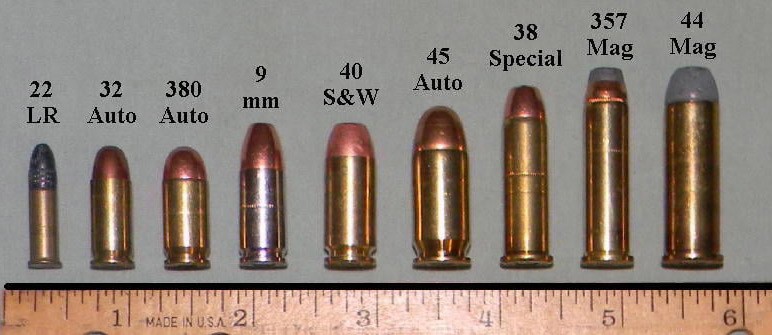What is all the talk about Caliber?
.22 LR, 9mm, .380, .45, oh my! What do all these random numbers on bullets mean and which one should you buy?
Whether you’ve already bought your gun or not, it’s a good idea to get an understanding of the different types of ammunition and which will best serve your purposes.
There are many types out there, but only a few are very common — and for good reason. They do an excellent job.
Let’s look at the common ones here.
What Is Caliber?
First of all, the caliber simply refers to the diameter of the gun barrel and thus which size cartridge will fit into it. When we are speaking of ammunition, Caliber is a measurement of a bullet’s diameter. It can be measured in both inches and millimeters (mm). For example, .45 ACP has a diameter of 0.451 inches and 9mm has a diameter of 9.01 mm.
Also, so that we’re all on the same page, the bullet refers to the metal projectile that leaves the gun, while the cartridge refers to the casing which holds the bullet and the powder (explosive the projects the bullet) and the primer, which ignites the powder when it is hit by the firing pin/striker — everything.
Cartridge / Powder / Primer / Velocity and Bullet Weight???
If you are shopping for ‘bullets’ then use the proper term… Ammunition or Ammo, for short. Cartridge is generally used when speaking about one piece of ammo. Asking for bullets may give you an unexpected result… a fist full of lead bullets (only the top). This is a common mistake of new gun owners, so don’t worry… people selling the product will keep you informed, as they want your repeat business ?
There can be different types of bullets that are the same caliber, and we will review this in our next article about bullet types. Hint… Ball ammo, hollow point…
OK, so we mentioned that the cartridge holds the powder, which creates the explosion that propels the bullet out of the gun, so, it makes sense, the more powder, the greater the explosion, the faster the bullet leaves. When looking for ammo, you will see the velocity of the bullet and/or energy. Both are determined heavily on the type of powder and amount of powder in the cartridge. A defensive shooter generally does not dig to deep here, but an advanced defensive shooter will learn about the velocity (speed of the bullet), which is also the energy – determined by the bullet’s mass and the velocity - that the bullet carries, as that does determine the penetration of the bullet, and ultimately the stopping power of the ammo.
As you advance, you will also learn about the bullet weight. Remember the bullet is the projectile, and the weight simply refers to the literal weight of the bullet, measured in grams. A heavier bullet will generally create more damage. Remember about velocity? A larger bullet will need more velocity, or the power will be reduced. These are advanced terms for advanced shooters.
Defensive Shooters For the basic defensive shooter… statistics show you will shoot your target at 3-5 yards, you will shoot 3-5 rounds, all in about 3-5 seconds…. So truly the velocity and bullet weight will have little to do with the outcome! Train to be accurate!
Let’s take a look at some of the most common calibers...
.22 LR
Want cheap ammunition for target practice? The .22 LR is the way to go. This small caliber cartridge is low on power, therefore has lower recoil (kick), therefore it is easy to shoot, making it perfect for beginners.
The .22 LR packs a punch, but because of the low power, lacks the ability to penetrate. It can kill a person but is not the best round for self-defense. Although not something you want to verify, know that the .22 will generally bounce off the skull of a person, not penetrating it. If hit center-mass, the bullet can bounce around inside a person, tearing up the organs and causing damage, it doesn’t stop a person in their tracks. .
.380
The .380 is the same caliber as the 9mm but has a relatively short range and less stopping power. Rembert… smaller cartridge has less powder, therefore less energy (power). The .380 is also sometimes referred to as the 9mm short.
People love this ammunition because of its low recoil and the ability to use it for concealed carry. As a relatively small cartridge, guns that shoot .380s are typically compact and easy to hide. They also work well for shooters with small hands who may not be able to handle the recoil of a more powerful round. The .380 is generally the first tier of defense guns.
9mm
Moving up to the 9mm, we find a round that is the modern “just right” in most categories. This is what makes this round extremely popular among law enforcement around the world. Technically, the 9mm is the same caliber as the .380, but with more gunpowder and thus more energy or stopping power.
There are a few different types of 9mm cartridges. However, the most popular one, the 9mm Luger or 9x9mm Parabellum, is so widespread that if you say just 9mm to anyone in the know, they will know you mean this one.
.40 S&W
.40 S&W was developed by Smith & Wesson in the late 1990s and designed based on the FBI’s demands. This then became the ‘hot’ caliber for several years and was the basic issue by many law enforcement departments. The added recoil and extra size of the cartridge was determined to be a hindrance, and most reverted back to the 9mm so they can fit a few more rounds (of ammo). Again, for basic defense… I would rather have 2 extra rounds than a slight advantage of power. If I miss a shot with a powerful gun, at the end, I would rather be able to take another shot from a slightly lower powdered round.
.45 ACP
The .45 ACP (Automatic Colt Pistol) was developed by John Browning for his new Automatic Colt Pistol. The caliber lives on and shortened to ACP, as the ammo is used in many guns from many manufacturers. This is great when you want some serious stopping power (think energy). It’s a large round with a bit more recoil then the smaller calibers, but the guns are generally heavier, which can offset the increase in recoil. The was “the” gun of caliber of the wild west and even through the 1980s. With the extra energy of more powder in the cartridge and the extra size of the bullet, this is a good choice for self-defense, just not so easy to conceal.
.38 Special (.357)
.38 Special is a revolver caliber. This is one of the few cartridges where the name is NOT the diameter size of the bullet but is the size of the cartridge. The bullet size is .357.
It was common amongst law enforcement until the development of the .40, that then dominated the law enforcement community for several years. Amongst differing factors between the revolver and semi-automatic pistol, the main is the limitation of capacity in a revolver. This is a very limiting factor when talking about defensive use. There are a few advantages of the revolver… simplicity (less chance of malfunction) and reasonable recoil.
.357 Magnum
.357 Magnum generally the .37 Special with more powder – creating more energy – creating more potential damage. There is a big jump in its velocity and energy compared to other calibers.
You can also shoot .38 Special in .357 Magnum revolvers, but you can NOT shoot .357 in a revolver designed for .38. The .38 revolver is not made to take the punishment of the larger forces that exist in the .357 magnum.
Choosing Your Ammunition
When you first buy a gun, it is highly recommended to take a class and learn about your weapon. You need to use and feel comfortable with it for it to be an effective tool for self-defense. A good class will also educate you on the types of gun ammunition and which one will best suit your purposes.
Looking for a good class? Check out what we offer here at DTT of Scottsdale, AZ - Defensive Tactical Training is set apart from the other trainers, as we encourage new gun owners to become versed in the sport through are SimCo classes and move on the live range courses. Ater our SimCo course you will be more confident at the range... ready to learn the techiniques to make you a better defender.
Train It > Master It > Protect It
About the author
Related Posts
By accepting you will be accessing a service provided by a third-party external to https://dtthq.com/
